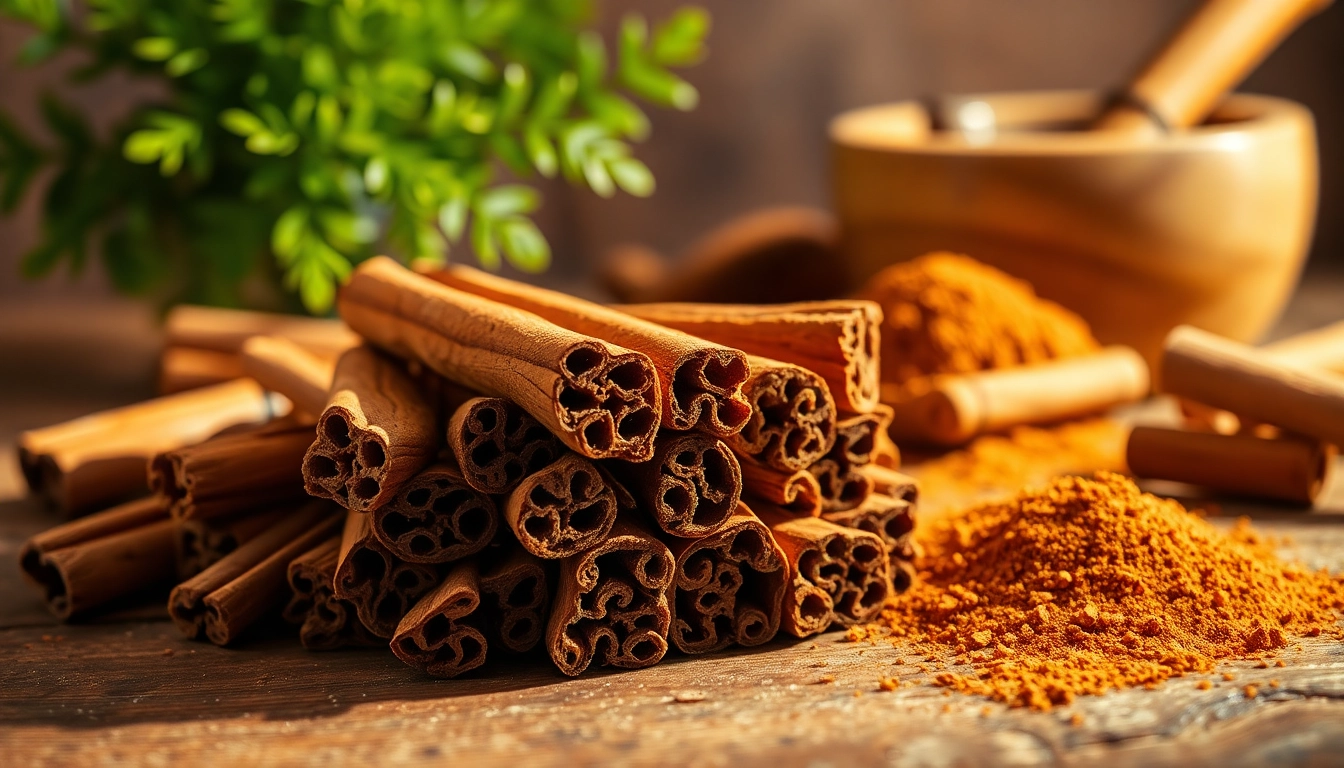Understanding Cinnamon Bark and Its Varieties
What is Cinnamon Bark?
Cinnamon bark is derived from the inner bark of trees belonging to the Cinnamomum genus. Revered for its distinct aroma and flavor, it plays a prominent role in culinary and medicinal applications worldwide. The use of cinnamon dates back thousands of years to ancient civilizations, where it was valued not just for its taste, but also for its numerous health benefits. The bark is typically dried and rolled into quills or ground into powder, making it a versatile ingredient in various dishes and remedies. A popular variety, Cinnamon Bark offers a unique blend of flavor profiles, enhancing both sweet and savory recipes.
Differences Between Ceylon and Cassia Cinnamon
There are two primary types of cinnamon: Ceylon and Cassia. Ceylon cinnamon, often referred to as “true cinnamon,” is native to Sri Lanka and has a delicate, sweet flavor with subtle notes of citrus. It features a thinner, multiple-layered bark which makes it easier to grind into a fine powder. Conversely, Cassia cinnamon, more commonly found in supermarkets, is characterized by a thicker, rough bark and a stronger, spicier flavor. It is primarily sourced from China and Indonesia and is often less expensive than Ceylon cinnamon. Understanding these differences is vital, as they not only influence culinary applications but also the potential health benefits attributed to each type of cinnamon.
Culinary Uses of Various Cinnamon Types
Cinnamon is a versatile spice used across diverse culinary traditions. Ceylon cinnamon’s sweet flavor makes it an excellent choice for baked goods, desserts, and beverages such as teas and coffees. It pairs exquisitely with fruits, nut butters, and oatmeal, adding warmth and depth to breakfast dishes. On the other hand, Cassia cinnamon’s robust flavor is well-suited for savory dishes, particularly in Middle Eastern and Asian cuisines where it enhances the complexity of stews, curries, and marinades. Both varieties can be used interchangeably in recipes, but adjusting the quantity may be necessary to achieve the desired flavor profile.
Health Benefits of Cinnamon Bark
Nutritional Profile of Cinnamon Bark
Cinnamon bark is a powerhouse of nutrients and beneficial compounds. It is rich in antioxidants, particularly polyphenols, which help combat oxidative stress and inflammation in the body. A tablespoon of ground cinnamon contains significant amounts of manganese, calcium, iron, potassium, and magnesium. These nutrients contribute not only to overall health but also to specific functions such as bone health and metabolic efficiency. Understanding the nutritional profile of cinnamon is crucial for anyone looking to incorporate it into their diet for health benefits.
Scientific Studies on Cinnamon Bark Benefits
Research has highlighted several of the health benefits associated with cinnamon bark. Studies indicate that cinnamon can help regulate blood sugar levels, making it particularly useful for individuals with diabetes. The active compound cinnamaldehyde has been shown to improve insulin sensitivity, enhancing glucose metabolism. Furthermore, cinnamon is known to have antimicrobial properties, providing protection against harmful bacteria and fungi. Ongoing research continues to explore its potential in reducing heart disease risk factors, such as cholesterol and triglyceride levels.
Common Medicinal Uses of Cinnamon Bark
Cinnamon bark has been used in traditional medicine for centuries. It is often recommended for digestive issues such as gastrointestinal upset and gas. The spice is also known to have anti-inflammatory properties, making it beneficial for alleviating pain associated with conditions like arthritis. Additional applications include its use in treating colds and flu due to its warming influence and potential to improve circulation. While cinnamon can support health, it’s essential to use it judiciously and consult with a healthcare provider if considering its use as a treatment option.
How to Use Cinnamon Bark in Cooking
Incorporating Cinnamon Bark into Recipes
Incorporating cinnamon bark into cooking requires a bit of creativity due to its potent flavor. For whole sticks, infusing the flavor into liquids is an effective method; simply add a stick to simmering soups, stews, or hot beverages. Ground cinnamon, on the other hand, can be easily added to spice blends, baked dishes, and oatmeal. Experimenting with different forms of cinnamon allows for unique flavor experiences. For instance, grinding Ceylon sticks using a mortar and pestle can release aromatic oils, enhancing the culinary dish.
Best Practices for Cooking with Cinnamon Bark
To maximize the flavor and health benefits of cinnamon bark, consider the following best practices:
- Pair cinnamon with complementary spices like nutmeg, clove, and ginger for enhanced depth in desserts and savory dishes.
- Use the whole stick in recipes that require longer cooking times, as it allows for a gradual infusion of flavor.
- In baking, ground cinnamon can be measured precisely to suit personal taste preferences—start with small amounts and adjust as needed.
- Consider toasting whole cinnamon sticks briefly in a dry skillet before using them to unlock their full flavor potential.
Pairings with Other Ingredients
Cinnamon pairs exceptionally well with a variety of ingredients. In sweet dishes, it complements apples, bananas, chocolate, and dairy products like milk and yogurt. In savory applications, cinnamon can enhance the flavors of root vegetables, meats, and legumes. The appeal of cinnamon is its ability to bridge both sweet and savory realms. Think about using it in Moroccan tagines, Indian curries, or Mediterranean pastries to create an aromatic experience.
Growing and Harvesting Cinnamon Bark
Overview of Cinnamon Cultivation
Cinnamon is cultivated primarily in tropical regions, with Sri Lanka, Vietnam, and Indonesia being the largest producers. The best conditions for growing cinnamon include warm, humid climates with well-drained soil. Cinnamon trees thrive in partial shade and require regular rainfall. Seedlings can take up to three years to mature before the bark can be harvested. Understanding the cultivation process is essential for anyone interested in sourcing high-quality cinnamon bark.
Harvesting Techniques for Quality Bark
Harvesting cinnamon bark involves a careful technique to ensure the health of the tree and quality of the bark. Harvesting typically occurs once the tree reaches around two years of age. Farmers cut the tree back to stimulate new growth, after which the inner bark is carefully scraped away. The outer layer of bark is peeled off, and the inner bark is then dried and rolled into quills. This artisanal approach is crucial for producing high-quality cinnamon that retains its flavor and aromatic properties.
Environmental Impact of Cinnamon Farming
While cinnamon cultivation offers economic benefits to many tropical countries, it also raises environmental concerns. Excessive farming can lead to deforestation and habitat destruction. Sustainable practices, such as agroforestry and respecting biodiversity, are essential to mitigate these impacts. Responsible growers are moving towards organic farming methods that not only support the environment but also produce a superior product that meets the growing demand for ethically sourced spices.
Choosing and Storing Cinnamon Bark
How to Select High-Quality Cinnamon Bark
Selecting quality cinnamon bark is crucial for achieving the best flavor and health benefits. Look for Ceylon cinnamon, characterized by its soft, multi-layered appearance. A fresh stick should be fragrant, with a sweet-spicy aroma. Avoid Cassia cinnamon that appears hard or brittle as it may be of lower quality. Opt for reputable suppliers who provide information about the source of their cinnamon, ensuring authenticity and quality.
Storage Tips for Freshness and Flavor
Optimal storage conditions are essential for preserving the freshness and flavor of cinnamon bark. Store cinnamon in an airtight container, away from light, heat, and moisture. Whole sticks can last for up to four years if stored properly, while ground cinnamon retains flavor for about six months. To extend its shelf life, consider refrigeration, especially in humid climates. Making a habit of checking expiration dates and freshness can prevent the use of stale cinnamon in recipes.
Common Mistakes to Avoid When Using Cinnamon Bark
Using cinnamon bark effectively requires some knowledge. Here are common mistakes to avoid:
- Overusing: Cinnamon is potent; use it in moderation to avoid overpowering dishes.
- Ignoring Quality: Cheaper, lower-quality cinnamon might not offer the same flavor or health benefits as premium varieties.
- Improper Storage: Failing to store cinnamon correctly can lead to a loss of potency and flavor.
- Using the Wrong Type: Not all cinnamon is created equal. Choose the right type for your intended use to achieve the best results.









